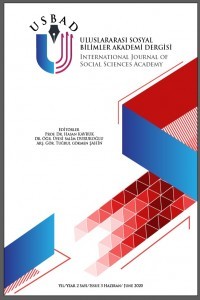SOSYAL MEDYADA KUSURSUZ HAYAT İLLÜZYONU: VLOGLAR VE GERÇEK HAYAT
İnternet ve sosyal medya kullanımı günümüzde hayatın ayrılmaz bir parçası haline gelmiştir. Birçok insan günün önemli bir bölümünü sosyal medyada geçirmektedir. Öte yandan, insanlar sosyal medyada genellikle hayatlarında her şey yolunda ve kusursuzmuş gibi paylaşım yapmaktadırlar. Nitel araştırma olarak tasarlanan bu çalışmanın amacı, sosyal medyada temsil edilen kusursuz yaşam imajını çalışma için seçilmiş vlog'lar üzerinden incelemektir. Bu amaçla, literatür taramasının ardından Youtube'da en çok abone olunan vloglar arasından 10 vlog hesabı seçilmiştir. Bu hesaplar fitness, güzellik, aile, yaşam tarzı ve seyahat kategorilerine göre analiz edilmiştir. Çalışmada, çalışmanın ana fikri ve araştırma problemleri ile uyumlu olacak şekilde, vloggerların kendilerini mutlu ve hayatlarından çok memnun olarak sundukları, hayatın problemli ve üzücü yönlerinden bahsetmedikleri görülmüştür.
Anahtar Kelimeler:
Sosyal medya, vloglar, kusursuz hayat, iletişim, gündelik hayat
THE ILLUSION OF FLAWLESS LIFE ON SOCIAL MEDIA: VLOGS AND REAL LIFE
Internet and social media use are an integral part of life today. Many people spend a significant part of their day on social media. However, people often post on social media as if everything is fine and flawless in their lives. The aim of this study, which is designed as a qualitative research, is to examine the flawless life image represented on social media through selected vlogs. With this aim, after the literature review, 10 vlog accounts were selected by random sampling among the most subscribed vlogs on YouTube. These accounts are analyzed according to the fitness, beauty, family, life style and travel categories. In the study, in line with the main idea of the study and research problems, it is seen that vloggers present themselves as happy and very satisfied with their lives and do not mention the problematic and sad aspects of life.
Keywords:
Social media, vlogs, flawless life, communication, everyday life,
___
- Alegado, A. (2019). The Instagram Illusion. Remote Address: https://mindsetpsychology.com.au/blog/the-instagram-illusion/
- Baudrillard, J. (1994). Simulacra and Simulation. Glaser, S. F. (Translated by). Ann Arbor: The University of Michigan Press
- Baudrillard, J. (2017) The Consumer Society: Myths and Structure. Los Angeles and London: Sage
- Bauman, Z. (2011) Liquid Modernity. Cambridge: Polity Press
- Benito-Osorio, D.; Peris-Ortiz, M.; Armengot C. R. & Colino, A. (2013) Web 5.0: The Future of Emotional Competences in Higher Education. Glob Bus Perspect 1, 274–287.
- Biel, J. I. & Gatica-Perez, D. (2010). Voices of Vlogging. Proceedings of the Fourth International AAAI Conference on Weblogs and Social Media.
- Black, P. (2004) The Beauty Industry: Gender, Culture, Pleasure. London and New York: Routledge.
- Burgess, J. & Green, J. (2009) YouTube: Online Video and Participatory Culture. Cambridge and Malden: Polity Press.
- Carlsson, U. (Ed) (2019). Understanding Media and Information Literacy (MIL)in the Digital Age: A Question of Democracy. UNESCO Dryden-Edwards, R. (2021) Duck Syndrome Facts. Remote Address: https://www.medicinenet.com/duck_syndrome/article.htmL.
- Flew, T. (2021). Media Convergence. Encyclopedia Britannica. Remote Address: https://www.britannica.com/topic/media-convergence.
- Giddens, A. (2006) Sociology. Cambridge: Polity Press.
- Goffman, E. (1959) The Presentation of Self in Everyday Life. London: Penguin Books.
- Gürsoy Atar, Ö. & Gürsoy Ulusoy Ş. (2020) Sosyal Medyada Ördek Sendromu: Instagram Üzerinden Bir Değerlendirme. İstanbul Ticaret Üniversitesi Sosyal Bilimler Dergisi 19(39), 925-951.
- History of the Web. (2021). Remote Address: https://webfoundation.org/about/vision/history-of-the-web/Hosch, W. L. YouTube. Encyclopedia Britannica. Remote Address: https://www.britannica.com/topic/YouTube. Date Accessed: 09.03.2021.
- Igi Global. (2021). What is Web 3.0. Remote Address: https://www.igi- global.com/dictionary/infoxication/32201.
- Kahraman, M. (2010). Sosyal Medya 101. İstanbul: MediaCat Yayınları.
- Kaplan, A. M. & Haenlein, M. (2010). Users of the World, Unite! The Challenges and Opportunities of Social Media. Business Horizons 53(1), 59-68.
- Leskin, P. & Haasch, P. (2021). These are the 30 Most Popular YouTube Stars in the World. Remote Address: https://www.businessinsider.com/most-popular-youtubers-with-most-subscribers-2018-2.
- Mai-Ly N. Steers, M. N., Wickham, R. E. & Acitelli, L. K. (2014) Seeing Everyone Else's Highlight Reels: How Facebook Usage is Linked to Depressive Symptoms. Journal of Social and Clinical Psychology 33(8), https://doi.org/10.1521/jscp.2014.33.8.701. Mayfield, A. (2008). What is Social Media. iCrossing. Remote Address: https://www.icrossing.com/uk/sites/default/files_uk/insight_pdf_files/What%20is%20Social%20Media_iCrossing_ebook.pdf.
- McLuhan, M. (1964) Understanding Media: The Extensions of Man. New York: McGraw-Hill.
- Merriam-Webster. (2021) Social Media. Remote Address: https://www.merriam-webster.com/dictionary/ social%20media Murugesan, S. (2007) Understanding Web 2.0. IT Professional 9(4), 34-41.
- Smart, B. (2017) Consuming Baudrillard: Introduction to the Revised Edition of the Consumer Society in Baudrillard, J. The Consumer Society: Myths and Structure. Los Angeles and London: Sage.
- Statista. (2021) Number of Social Network Users Worldwide from 2017 to 2025. Remote Address: https://www.statista.com/statistics/278414/number-of-worldwide-social-network-users/
- Tolson, A. (2010) A New Authenticity? Communicative Practices on YouTube, Critical Discourse Studies 7(4), 277-289.
- Tüfekçi, Z. (2008). Can You See Me Now? Audience and Disclosure Regulation in Online Social Network Sites. Bulletin of Science, Technology & Society 28(1), 20-36.
- Van Dijck, J. (2013). The Culture of Connectivity: A Critical History of Social Media. Oxford and New York: Oxford University Press.
- Van Dijck, J. (2020). The Network Society. Los Angeles and London: Sage Youtube in Numbers (2021). Remote Address: https://www.youtube.com/intl/en-GB/about/press/
- Başlangıç: 2019
- Yayıncı: Salim DURUKOĞLU
Sayıdaki Diğer Makaleler
SOSYAL MEDYADA KUSURSUZ HAYAT İLLÜZYONU: VLOGLAR VE GERÇEK HAYAT
ÇEVRE DİL BİLİMİ BAĞLAMINDA DAVID CRYSTAL’İN “DİLLERİN KATLİ” ADLI ESERİ ÜZERİNE BİR ANALİZ
SAĞ POPÜLİZM VE FAŞİZM KAVRAMLARININ KARŞILAŞTIRMALI İNCELEMESİ: ENTEGRALİSTLER ÖRNEĞİ
YANLIŞ BİLİNÇ VE ÖZGÜR İRADE BAĞLAMINDA “DEVİL'S ADVOCATE” FİLMİNİN ANALİZİ
AMERİKALILARIN HARPUT’TAKİ MİSYONERLİK FAALİYETLERİ
OGSP’NİN GELİŞİM SÜRECİ: BİR GÜVENLİK AKTÖRÜ OLARAK AB
CISCO DİJİTAL HAZIRLIK ENDEKSİNDE TÜRKİYE İÇİN PERSPEKTİFLER
GPT3: DALL-E VE JL2P EKSENİNDE VERİ GÖRSELLEŞTİRME VE HAREKETLENDİRME ÜZERİNE BİR İNCELEME
YOLCULARIN HAVAYOLU İŞLETMELERİNİN MOBİL UYGULAMALARINI KULLANMASINI ETKİLEYEN FAKTÖRLER
Nuriye GÜREŞ, Mutlu Yüksel AVCILAR, Seda ARSLAN
